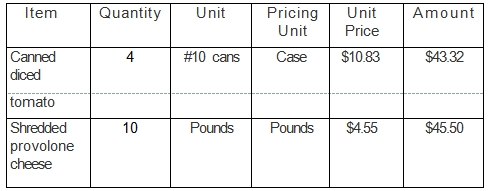 By Douglas R. BrownAtlantic Publishing
By Douglas R. BrownAtlantic Publishing
Part 6: Purchasing and Ordering--Procedures and Practices
Purchasing and Inventory Software
Purchasing and inventory software is readily available to restaurant operators. Many larger organizations are using inventory control software that saves a significant amount of time and money. Most managers are used to the monthly grind, standing in the walk-ins counting eggs, butter pats and frozen chickens. With inventory control software, managers can use a laser scanner, similar to the ones used in grocery stores, to scan bar codes. The software can also be linked to your distributors and you can place your orders electronically based on the inventory.
- Consider placing your orders online. Almost all distributors now have systems in place to order online. The advantages are numerous: it reduces ordering errors, it's convenient, there may be discounts, and most systems build a customer database based on what you have previously ordered making re-orders easy. A list of vendor Web sites follows:
www.sysco.com
www.seafax.com/cgi-bin/WebObjects/Seafax
- Use written purchase orders (PO). A PO is a written authorization for a vendor to supply goods or services at a specified price over a specified time period. Acceptance of the PO constitutes a purchase contract and is legally binding on all parties. Utilizing POs will enable you to know what was ordered, the quantity, and the price. If you are using software to record the invoice and receipt of inventory, the program will restock and adjust pricing automatically. In addition, your perpetual inventory will be updated. Purchase orders from software programs can easily be faxed or e-mailed into the vendor, saving time and money.
- When purchasing food, avoid more expensive name brands wherever possible. Of course, you want to make sure you're buying quality ingredients for your food, but are your customers really likely to tell the difference between a "name brand" and an "industrial brand"?
- Local growers. Talk to local fresh-produce suppliers to see if you can't get fresher, cheaper, better-quality fresh produce direct from the grower. Why pay a supplier to get the fruit and vegetables that are shipped to their central warehouse, then shipped back to you, when you can just drive 10 minutes down the road and enjoy food right off the tree or vine? You can also use this as a promotional device. If you use local produce, let your customers know!
- Cooperative purchasing. Many restaurants have formed cooperative purchasing groups to increase their purchasing power. The cooperatives purchase items that are commonly used by all food service operators. By joining together to place large orders, restaurants can usually get substantial price reductions. Some organizations even purchase their own trucks and warehouses and hire personnel to pick up deliveries. This can be advantageous for restaurants that are in the proximity of a major supplier or shipping center. Many items, such as produce, dairy products, seafood and meat, may be purchased this way. Chain restaurants have a centralized purchasing department and, often, large self-distribution centers.
- Make sure you shop for purveyors. Don't rest once you've found one. Comparison shop on a continual basis.
- Look at vendors' product labels for box strength. This will tell you where the product came from. Most manufacturers won't ship more than 100 miles away from their plants. The further away that a supplier is located, the more shipping will cost.
- Consider planting your own herb and/or vegetable garden. Great food starts with using the freshest herbs and vegetables and the best way to do that is to grow them yourself! The techniques for growing your own are not difficult. With a little planning, you can build your own 24-hour supply of garden-fresh herbs. Even a small garden can infuse your kitchen with heavenly aromas and striking flavor. What a great way to lower your food cost and separate yourself from the competition! You can buy seeds online at:










 Vodka/Tom Collins
Vodka/Tom Collins 
